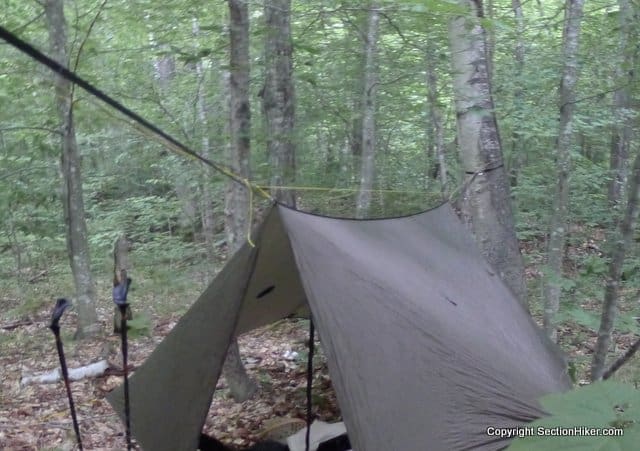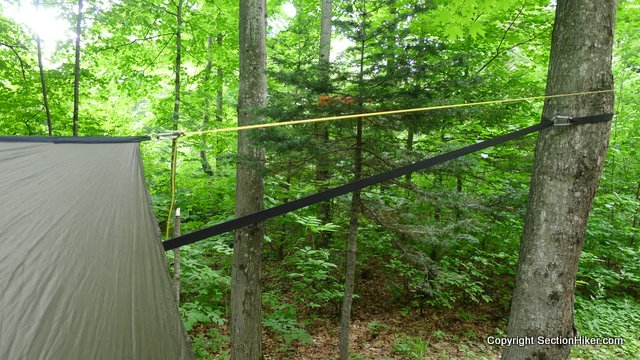How to Set Up a Tarp Using a Ridgeline

Many hammock hangers choose a continuous ridgeline for suspending their tarps between two trees. I used this technique after buying a Warbonnet Blackbird hammock and Superfly tarp from a friend who'd set up his tarp suspension system this way, but quickly discarded and replaced it with something much simpler called a two-line or split-line system using Dutchware Stingerz.
Continuous Ridgelines
A continuous ridgeline suspension system has two main parts:
- The ridgeline, a long piece of cord that you tie between two trees – 25 to 30 feet of ZingIt (urethane coated dyneema fiber) is a good length. People often secure the ridgeline to trees using metal hardware instead of a knot, like a Dutchware Hook at one end and a Wasp at the other, but there are a thousand variations.
- A pair of prusik knots attached to the ridgeline, You attach the ends of your tarp to the prusik knots so you can slide the tarp back and forth along the line, in order to quickly position it over your hammock, so that the ends are covered by your tarp.
Don't know what a prusik knot is? (see this video) It's also called a triple sliding hitch. It's a way to secure a self tensioning loop on a line so it can slide along it and then lock in place when put under tension.
Pros and Cons of Continuous Ridgelines
The biggest benefit of the continuous ridgeline system is that it gives you the ability to quickly slide your tarp into position over your hammock. Assuming you set up your tarp first, this helps you keep your hammock dry in the pouring rain, because you can move it over your hammock body after you attach the first set of webbing to a tree.
While a continuous ridgeline system is kind of complicated to set up if you want to do it yourself (especially if you're trying to come up the newbie hammock learning curve),you can buy pre-fabricated continuous ridgeline systems that take the guesswork out of sourcing your own cord, hardware, and knots.
But continuous ridgeline systems fail when the prusik knots jam up and won't move without some serious two-handed fiddling to loosen them up. This turns into a wet clown show if it's chucking down rain when you're trying to hang your hammock, because you don't discover the jam until after you've lashed the first set of hammock webbing to a tree and your hands are full of hammock. While you can avoid this scenario by replacing the prusik knots with yet more hardware, such as Tato Tarp Connectors, you have to wonder whether all of this line management, not to mention your tarp guy-outs, is really worth hassling with.
I decided it wasn't.

A Two-Line Hammock Tarp Suspension
In the two-line hammock tarp suspension, you run separate lines from the tarp ridgeline to a tree. It's about as basic as you can get. I attach a Dutchware Stingerz to the tarp using its built-in biner clip, and then run a 15′ ZingIt line tied to the Stingerz around the tree and back to the Stingerz, where I lash it around the antenna. The hook on the Stingerz makes it possible to put a lot of tension on the line, much like the loop on a trucker's hitch knot.
Dutch demonstrates:
This system usually doesn't require any tarp repositioning because I use a Warbonnet Superfly which is a very large 11 x 10 foot tarp with end doors. The Superfly overlaps the ends of my hammock by 15-16 inches on each side and I can easily adjust the length of the hammock webbing if necessary to get it under the tarp in pouring rain, since my hands are free.
I like this system better than a continuous ridgeline because it goes up very fast, it can be adjusted very quickly if necessary since I'm using hardware instead of knots, and there's much less line management involved. I can also easily move the Stingerz and cordage to other tarps I use in no time, simply by unclipping the Stringerz biner from the tarp.
On hindsight, I can't help wonder if continuous ridgeline system wasn't first developed as a workaround to using smaller hammock tarps, where there was much less overlap between a tarp and a hammock. Just a thought, but it would provide a historical explanation for why people still use continuous ridgelines with much larger tarps.
Published 2015.
Editor's note: If you're thinking about buying gear that we've reviewed or recommend on SectionHiker, you can help support us in the process. Just click on any of the seller links above, and if you make a purchase, we may (but not always) receive a small percentage of the transaction. The cost of the product is the same to you but this helps us continue to test and write unsponsored and independent gear reviews, beginner FAQs, and free hiking guides. Thanks and we appreciate your support!
Most Popular Searches
- tarp continuous ridgeline vs split line
How to Set Up a Tarp Using a Ridgeline
Source: https://sectionhiker.com/hammocks-continuous-ridgelines-or-not/
0 Response to "How to Set Up a Tarp Using a Ridgeline"
Post a Comment